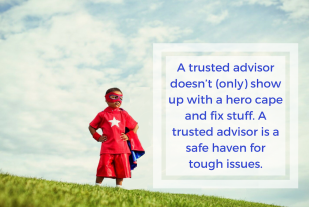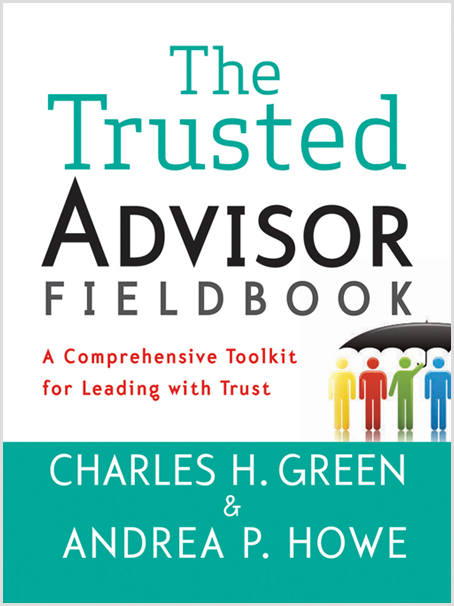This post is part of our Weekly Tips series.

It’s one thing to conceptually grasp the different ways you can offer value to clients, including the ways that a trusted advisor truly stands apart. It’s another thing entirely to embody it such that your in-the-moment reactions are consistent with your intentions. Take this little test to find out how well you generally do.
The scenario: You walk in to a client meeting, well prepared and with an already agreed-upon agenda. You exchange pleasantries as you take your seats, asking your client how things are going. He sighs loudly and says, “You know, it’s been a rough couple of weeks.”
As a trusted advisor, what would you say next?
Take a moment to write it down, then see how close you get to the “right” answer.
If you see yo ur value as more transactional, where your primary talents are to provide information and steer conversations towards specific business outcomes, you’ll likely see your client’s expression of emotion as atangent—a distraction from the task at hand—and say something well-meaning like this:
But you probably know better than that. You generally pick up on your clients’ cues, and you know not to ignore them.
Or do you?
There’s great risk that you’ll hear your client’s expression of concern in this case and immediately step in as problem-solver, not trusted advisor. Your well-meaning response will be something like this:
Or the slightly more advanced:
One of these two responses is the most common for savvy professionals because you’re hard-wired to don your hero cape and fix stuff. Of course, it’s not bad to fix stuff; it just creates a more narrow relationship.
By contrast, when you see your value as a trusted advisor, or safe haven for tough issues, you’ll say something like this:
Then … and this is important … you’ll pause to see where your client takes the conversation.
That’s a dramatically different in-the-moment response that reflects a profoundly different relationship, where you recognize that your client might need a sounding board for a tough issue the most—consciously or not. (Which might, by the way, be a tough issue that you know a lot about, a little about, or nothing about.)
Or your client might want to get right to the first agenda item. Either way, by responding to your client’s comment in an open and empathetic way, you’ve demonstrated some important things:
- You’re paying attention;
- You’re willing to go wherever your client wants to go;
- You’re not afraid to deal with topics that might be emotionally-charged;
- You’re the kind of person others can talk to about just about anything—whether they choose to take advantage of that now, later, or never.
By the way, I’m going to repeat a variation of something I said last week because it bears repeating: it’s tempting to think that your ability to be a trusted advisor is mostly out of your control because it depends on your clients’ desire for it, when that’s usually not true. If you wait for an invitation, you may never get it. You have to see your own value more broadly, and take a risk to create trust.
Excerpted from Trusted Advisor 24×7:The Video Series.
Make It Real
This week, practice being in trusted advisor mode rather than problem-solver mode. Create some quick improv drills with a colleague. Explore different empathetic ways to respond to your clients’ “tangents.” What do you discover?
Learn More

Discover why“premature solutions” is also the most pervasive problem in sales, from our friends at Trusted Advisor Associates, or brush up on other improv drills to help you raise your game in Chapter 8 of The Trusted Advisor Fieldbook.
Andrea Howe
Latest posts by Andrea Howe (see all)
- Why choosing silence in the face of awkwardness can be a trust tragedy - March 21, 2024
- What NOT to do when you think you’re being ghosted - February 21, 2024
- Reprise: If you’ve resolved to have better client relationships this year, great, now ditch your resolution - January 2, 2024

Dec 17 tip: A test: What would a trusted adviser say next?
Here’s my answer: Tell me more, What’s been so rough?
Why? Because I want to meet my clients, first of all, as people, not paychecks..
And if they’re emotions are all focused on some negative issues, I’d like to understand what they’re feeling. Sometimes just saying things out loud creates a sense of empathy – even if I don’t have anything to offer but listening.
Then I can better gauge whether my client is prepared to move forward as previously planned or if there’s some changes to be made.
One more thing – I am big on self talk – and at moments like these, I tell myself, again,
I am not afraid to have a client cancel a project – especially for reasons that have nothing to do with me.
My obligation to my client is to put their needs ahead of mine – and when I don’t do that – when I worry about the client’s commitment to this particular project – I’ve made my own benefit a higher priority.
P.S.This is why I believe that the age-old mantra of “The client is always right” is wrong.
Loraine, I am embarrassed to only just now discover your comments from four months ago. A change in tech support for the website will help me be sure this never happens again.
I appreciate your comments very much, especially the one about self-talk, and your willingness to put your clients’ needs first (for real). This is easier said than done, and is the mark of a true trusted advisor. Charlie Green uses a mantra I like very much, which is, “Let me be a channel.” In other words, let me stay focused on being the helpful conduit for whatever good outcome (for the client) is meant to come of this.
I also think your “Tell me more” suggestion is key–three simple words that can open up worlds. I suggest one small upgrade, which is to offer some kind of empathetic expression *before* the “tell me more” (which could be verbal or non-verbal, and could be very brief) so you are first and foremost meeting emotion with emotion, and then moving on the substance.
Again, thanks for your thoughtful contribution.